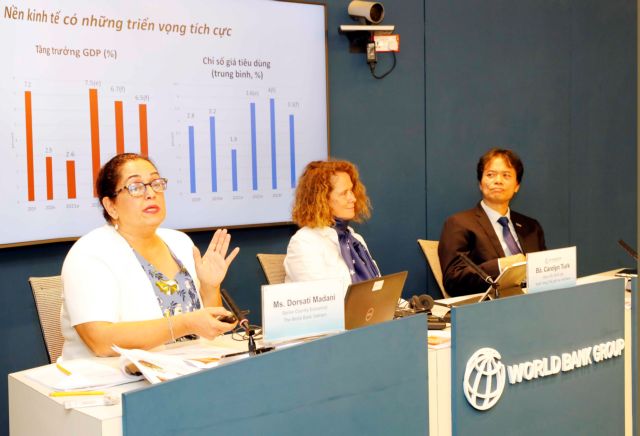 |
| Sài Gòn New Port - the most modern and largest port in Việt Nam with a market share of import-export containers accounting for more than 60 per cent of the country's figure. — VNA/VNS Photo Hồng Đạt |
HÀ NỘI — Việt Nam’s GDP growth is forecast to surge from an estimated 2.6 per cent in 2021 to 7.5 per cent in 2022, with resilient manufacturing and a robust rebound in services serving as the driving forces for economic recovery.
According to the latest economic update by World Bank (WB) for Việt Nam, the country’s economy expanded 5.2 per cent in Q4 of 2021, and respectively 5.1 per cent and 7.7 per cent in Q1 and Q2 of 2022.
Inflation is projected to average 3.8 per cent over the year.
Carolyn Turk, WB Country Director for Việt Nam, said that the bi-annual report “lays out a set of policy recommendations that could help mitigate the impact of these risks and make the economy more resilient going forward.”
Titled “Taking Stock: Educate to Grow”, this edition underlines transforming the higher education system as the key to boosting the country’s productivity and achieving its development goals, in the context where the country re-emerges from the pandemic and into a challenging global environment.
The report’s co-author Dorsati Madani said that while Việt Nam’s economic recovery had been relatively stable, not all sectors witnessed the same situation.
The impact on workers and households during the crisis was serious and lasting, with about 45 per cent claiming lower incomes in December 2021 than the previous year.
The impact of the pandemic is still present with businesses reporting broad-based labour shortages as of March 2022, which were felt more acutely in services and manufacturing, and in the HCM City area.
This, in addition to growth slowdown or stagflation in main export markets, further commodity price shocks, continued disruption of global supply chains, or the emergence of new COVID-19 variants, are hindering Việt Nam’s full recovery.
 |
| Dorsati Madani, World Bank's senior economist and co-author of the report, speaks at the launching event. — VNA/VNS Photo Trần Việt |
Statistics revealed that Việt Nam’s population has an average 10.2 years of schooling, second only to Singapore among the Association of Southeast Asian Nations (ASEAN) countries.
Việt Nam’s human capital index is 0.69 out of a maximum of 1, the highest among lower middle-income economies.
However, low skills relevance of the university graduates put the country in the bottom third of the 140 countries listed in the 2018 Competitiveness Index on skills relevance of university graduates.
A World Bank skills and enterprise survey published in 2019 also said that 73 per cent of sampled Vietnamese firms report difficulties in recruiting employees with leadership and managerial skills, 54 per cent with socio-emotional skills, and 68 per cent with job-specific technical skills.
Focusing on tertiary and higher education, the WB’s report recommends reforming the education system to improve quality and access, and thus provide the necessary skills to the population.
Reforms to Việt Nam’s higher education system could help support development objectives, the report says.
The increasing financial costs of pursuing higher education and the perception of diminishing economic returns from pursuing higher education have weakened demand.
While efforts to enhance the business environment are crucial to enabling job creation, policymakers should also take steps to reduce skill-mismatches and improve the quality of Việt Nam’s labour force.
Turk said: “To sustain economic growth at the desired rate, Việt Nam needs to increase productivity by 2-3 per cent every year.
“International experiences have shown that higher worker productivity can be achieved by investing in the education system, as an important part of a basket of investments and reforms. A competitive workforce will generate much-needed efficiency for Việt Nam in the long term.” — VNS
 Việt Nam hopes to attract more capital from South Korea
Việt Nam hopes to attract more capital from South Korea  Another reason to want the corner office: It's good for your health
Another reason to want the corner office: It's good for your health  How to make a QR code for your office for customer health declaration during the Covid-19 pandemic
How to make a QR code for your office for customer health declaration during the Covid-19 pandemic  VIETNAM REAL ESTATE INVESMENT MARKET OVERVIEW AND OUTLOOK Q2.2023
VIETNAM REAL ESTATE INVESMENT MARKET OVERVIEW AND OUTLOOK Q2.2023  Virtual Office vs. Shared Office – Which is best for your workspace needs?
Virtual Office vs. Shared Office – Which is best for your workspace needs? 2 Bis - 4 - 6, CJ BUILDING
No. 6 Le Thanh Ton street, Sai Gon Ward, HCMC
Tel: +84 28 6255 6800 | Fax: +84 28 6255 6801
Email: leasing@cjbuilding.com.vn



